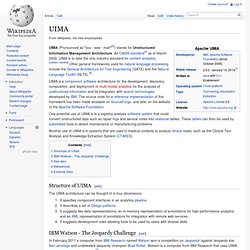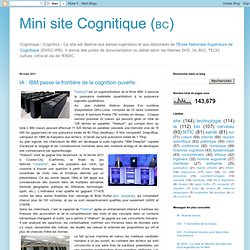

IBM Watson Developer Cloud. Dolphin. Download Dolphin Description The goal of “Dolphin” for “Grasshopper” is to support the early stages of the design process using information technology in order to find architectural solutions as a source of inspiration, an explicit solution, or a means to better understand current design problems.

The “Dolphin” plugin allows the use of digital semantic building information in the parametric work environment of “Grasshopper” and “Rhinoceros” using the XML-based AGraphML exchange format developed by the “KSD research group”. The AGraphML format stores spatial and topological information that can be accessed through local sources and web-based sources. The information can either be downloaded in AgraphML files or accessed using a building information cloud directly that handles spatial information in a graph database, geometric information on a BIM Server and meta-information in a content management system.
IBM Watson Analytics. Formation - Développement d'applications avec Neo4j, cours à Paris - 7ème, Toulouse. Les données sont aujourd'hui de plus en plus connectées entre elles, ce que nous démontre chaque jour l'explosion des réseaux sociaux.

Pour gérer de manière optimale ces relations toujours plus nombreuses, une branche de la famille NoSQL est en plein essor : les bases de données graphes. Neo4j en est le leader. En plus d'être Open Source, Neo4j a déjà fait ses preuves dans des domaines très variés tels que les télécoms, la finance, les réseaux sociaux ou l'industrie spatiale. A l'issue de cette formation vous pourrez décider de l'opportunité d'utiliser des bases de données NoSQL de type graphe sur vos projets. Le cas échéant, vous connaîtrez les étapes pour utiliser Neo4j, de la modélisation sous forme de graphe jusqu'à la manipulation des objets et leurs relations. Vous allez apprendre à : Méthode pédagogique : 50% de travaux pratiques Audience : Développeurs, architectes Pré-requis : Connaissances en programmation Java ou avoir suivi le cours JOD ou IJOP.
Linked Data. Cortical.io - Semantic Fingerprinting. 12th ESWC 2015. Content extraction with apache tika. Apache Tika - Apache Tika. Semantic tools for big data. Robust Hyperlinks. Proceedings of Digital Documents and Electronic Publishing (DDEP00), Munich, Germany, 13-15 September 2000 In Springer-Verlag Lecture Notes in Computer Science.

Copyright © 2000 Springer-Verlag Thomas A. Phelps and Robert Wilensky Division of Computer Science University of California, Berkeley Berkeley, CA 94720-1776phelps@cs.berkeley.edu, wilensky@cs.berkeley.edu Web Site Abstract. Robust hyperlinks exhibit a number of desirable qualities: They can be computed and exploited automatically, are small and cheap to compute (so that it is practical to make all hyperlinks robust), do not require new server or infrastructure support, can be rolled out reasonably well in the existing URL syntax (so they can retrofit existing links to make them robust), and are easy to understand. Robust hyperlinks are one example of using the web to bootstrap new features onto itself. Table: Sample Signatures and Query Results. URLsignatureServerRobust ok? 3. 3.1 Encoding Signatures in URLs Robust Browsers. ConceptNet 5. UIMA - Standard for unstructured information.
UIMA is a component software architecture for the development, discovery, composition, and deployment of multi-modal analytics for the analysis of unstructured information and its integration with search technologies developed by IBM.

The source code for a reference implementation of this framework has been made available on SourceForge, and later on the website of the Apache Software Foundation. Another use of UIMA is in systems that are used in medical contexts to analyze clinical notes, such as the Clinical Text Analysis and Knowledge Extraction System (CTAKES). Structure of UIMA[edit] The UIMA architecture can be thought of in four dimensions: IBM Watson - The Jeopardy Challenge[edit] In February 2011 a computer from IBM Research named Watson won a competition on Jeopardy! See also[edit] References[edit] External links[edit] Supercalculateur sémantique. "Watson" est un superordinateur de la firme IBM.

Il associe la puissance matérielle (quantitative) à la puissance logicielle (qualitative). Au plan matériel, Watson dispose d'un système d'exploitation GNU-Linux, composé de 10 racks contenant chacun 9 serveurs Power 750 montés en réseau. Chaque serveur possède 32 coeurs qui peuvent gérer un total de 128 tâches en parallèle. "Watson", qui compte donc au total 2 880 coeurs pouvant effectuer 11 520 tâches en parallèle, possède une mémoire vive de 15 000 Go (gigaoctets) et une puissance totale de 80 Tflop (téraflops). À titre comparatif, Deep-Blue, vainqueur en 1966 de Kasparov aux échecs, (n')avait (qu')une puissance totale de 1 Tflop. Au plan logiciel, les chercheurs de IBM ont développé la suite logicielle "IBM DeepQA" capable d’analyser le langage et les connaissances humaines dans des contexte ambigu et de développer ses connaissance par apprentissage. Index of /pubs/crosswikis-data.tar.bz2.